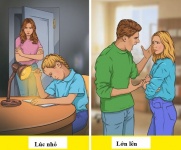Sự thật về những người thuận tay trái trong tiếng Anh
Phần 1
If you know an older …(1)… person, chances are they had to learn to write
or eat with their right hand. And in many parts of the world, it's still common …(2)…to force children to use their "proper" hand. Even the word for right
also means correct or good, not just in English, but many other languages, too. But if being left-handed is so …(3)…, then why does it happen in the first place?
Today, about 1/10 of the world's population are left-handed. Archeological evidence shows that it's been that way for as long as 500,000 years, with about 10% of human remains showing the associated …(4)…in arm length and bone density, and some ancient …(5)…and artifacts showing evidence of left-hand use. And despite what many may think, handedness is not a …(6)…
It can be predicted even before …(7)…based on the fetus' position in the womb. So, if handedness is inborn, does that mean it's genetic? Well, yes and no.
Identical …(8)…, who have the same …(9)…, can have different dominant hands. In fact, this happens as often as it does with any other sibling pair. But the chances of being right or left-handed are determined by the handedness of your …(10)…in surprisingly consistent ratios.
Từ mới:
archeological: khảo cổ học
handedness: khuynh hướng chỉ dùng một tay
fetus: thai nhi
womb: bụng mẹ
inborn: bẩm sinh
genetic: di truyền
dominant hands: tay thuận
Theo VnExpress
Nguồn: Gia đình Việt Nam
 Học tiếng Anh: Cậu bé 6 tuổi phân biệt các loài khủng long
Học tiếng Anh: Cậu bé 6 tuổi phân biệt các loài khủng long- Từ vựng tiếng Anh cần biết khi đi chùa
- Bé nói tiếng Anh: Dùng lì xì mua ôtô cho bố
 Sản phụ hạ sinh bé trai khỏe mạnh trong khu cách ly Covid-19
Sản phụ hạ sinh bé trai khỏe mạnh trong khu cách ly Covid-19  Cô bé Trung Quốc 7 tuổi chạy 10km mỗi ngày để giúp chị được sống
Cô bé Trung Quốc 7 tuổi chạy 10km mỗi ngày để giúp chị được sống  5 sai lầm của cha mẹ khiến con mất tự tin, ảnh hưởng đến cả tương lai của con
5 sai lầm của cha mẹ khiến con mất tự tin, ảnh hưởng đến cả tương lai của con  Bộ ba lá chắn thần thánh “Sắt - vitamin C-Kẽm”: tăng cường miễn dịch cho trẻ nhỏ, chống lại tác nhân xấu từ bên ngoài
Bộ ba lá chắn thần thánh “Sắt - vitamin C-Kẽm”: tăng cường miễn dịch cho trẻ nhỏ, chống lại tác nhân xấu từ bên ngoài
 Thực đơn cơm nhà 4 món chưa tới 100.000 đồng, rất thích hợp cho ngày mát trời
Thực đơn cơm nhà 4 món chưa tới 100.000 đồng, rất thích hợp cho ngày mát trời  10 kiểu tóc uốn layer phù hợp với mọi gương mặt chẳng bao giờ lo lỗi mốt
10 kiểu tóc uốn layer phù hợp với mọi gương mặt chẳng bao giờ lo lỗi mốt  Bạn trai tung ảnh tình tứ bên H'Hen Niê, vẫn dùng cách quen thuộc để che mặt đối phương
Bạn trai tung ảnh tình tứ bên H'Hen Niê, vẫn dùng cách quen thuộc để che mặt đối phương  4 loại vắc-xin dịch vụ rất cần cho trẻ nhỏ: Cha mẹ nhớ kỹ
4 loại vắc-xin dịch vụ rất cần cho trẻ nhỏ: Cha mẹ nhớ kỹ
- 1Dấu hiệu nhận biết "100%" mẹ bầu mang thai bé trai
- 2Hướng dẫn cách cho trẻ ăn hoa quả theo từng tháng tuổi
- 3Mang thai con đầu lòng thường bao nhiêu tuần thì sinh?
- 4"Chuẩn không cần chỉnh" cách tính sinh trai, gái của cổ học phương Đông
- 511 biểu hiện bất thường ở cơ quan sinh dục bé trai mẹ không được bỏ qua








